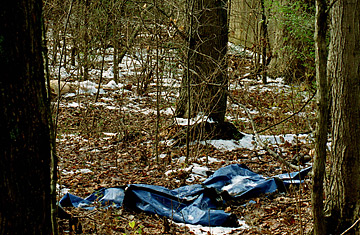
The remains of two bodies can be seen between the trees at the Anthropology Research Facility, also know as the Body Farm, at the University of Tennessee Campus in Knoxville, Tennessee.
The CSI TV shows are among the most watched in the world. But forensic science is hitting a little close to home for some Texas property owners, who oppose plans for a nearby "body farm," where decomposing bodies will be studied in the wild.
In this real-life episode of CSI: Nimby — not in my backyard — residents of a rural area near the San Marcos Airport, 30 miles south of Austin, have objected to plans by Texas State University to build a 17-acre body farm nearby. With three acres designated for research and surrounded by a wide fenced boundary, plus cages over the exposed bodies, university officials assured residents there would no problems.
But neighbors complained that the facility would affect property values and attract coyotes and vultures. TSU had to abandon the site, over concerns that gathering vultures would threaten aircraft, and university officials say the body farm will be built elsewhere in the area.
The TSU facility would be the third such body farm in the country and the largest. Criminologists and forensic anthropologists use these research facilities to study how bodies decompose and at what rate in various natural environments. The research can be grisly but valuable. Forensic entomologists observe insects — beetles, flies, worms and even butterflies — that feed on flesh and body fluids at specific times in the decomposition process, offering critical clues to law enforcement about time and place of death. Insect behavior also can hold the key to finding a body; flocks of the beautiful Southern pearly eyed butterfly, for example, gather to feed on sugar-rich body fluids. Some of the bodies are donated; others are unclaimed at morgues; to simulate the manner in which many murder victims are found, they are either buried or left exposed and covered by wire cages.
The first facility at the University of Tennessee Forensic Anthropology Facility, was opened on a three-acre site in Knoxville in 1971 by noted anthropologist William Bass. Prolific crime writer Patricia Cornwell popularly dubbed it a "body farm" in her novel of the same name. Bass himself has co-written a series of best-selling novels set on the farm; the first, Carved in Bone, was described as "southern-fried forensics" by Kirkus Reviews.
The popular appetite for forensic stories is seen not just in novels and on TV but in a new CSI exhibit at Chicago's Museum of Science and Industry. Across the country more universities are adding forensics classes to their criminology programs. In addition to the proposed TSU facility, Florida Gulf Coast University in Ft. Myers and Chico State in California are planning their own outdoor criminology labs.
"Body farms are springing up all over," says renowned Louisiana State University forensic anthropologist Dr. Mary Manhein. She has amassed a large database dubbed FACES (Forensic Anthropology and Computer Enhancement), based on skeletal and dental structure data gathered from murder victims and research cadavers, some from body farms. The data is used to help reconstruct 3-D portraits of skeletal remains. While she has no plans for a body farm at LSU — the facilities can be expensive and pose security problems — she said they do provide important research for forensic anthropologists and criminologists.
Jason Byrd, a well-known forensic entomologist, says that body farms are becoming more important as stranger-on-stranger crime is on the increase. In cases where the victim is related to the murderer by family, financial or social bonds, police often use these connections to help solve cases. "Now there are more random acts of violence and we have less and less avenues to turn to," says Byrd. Body farms cannot be set up to mimic every kind of environment, of course, but already they have given southern criminologists vital research — for example, bodies decompose in Florida in three days, compared with 30 days in the mountains of Tennessee.
"Nobody likes to talk about it. It's politically uncool — putting a human body out and letting it decompose — but unfortunately it is a necessary artifact of human society," Byrd says. Once the cadaver has been exposed to open air, the bones picked clean by wildlife and insects, the skeletal remains are studied, then measured, catalogued and archived.
More controlled research on human cadavers also would help in the courtroom, Byrd says, since the current method of using hog carcasses to determine key facts like probable time of death is often challenged.
In the past, law enforcement often relied on officers who were close to retirement or on "desk status" to serve as crime scene investigators, but there's now recognition that criminologists need a solid science background. "There has been a change in mentality," Byrd says. "CSI has glamorized the work and that has caused a lot of attention and with publicity there often comes funding."
CSI: Nimby will continue in Texas and likely elsewhere, but TSU is "absolutely committed" to building its outdoor research facility, TSU spokesman Mark Hendricks says. The plan, endorsed by several Texas law enforcement agencies, is part of an enhancement of the universitys forensic anthropology program. The goal, Hendricks says, will be to build a doctoral program; there are less than a dozen in the country.
